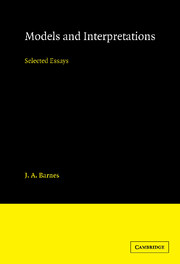13 - Modelling: for real or for fun? (1983b)
Published online by Cambridge University Press: 08 January 2010
Summary
Having looked at two classes of models, in part I at models of various aspects of the social world and in part II at models of intellectual formations associated with social science, we finally turn to look at the process of modelling itself. The stimulus to write this paper came from an invitation to talk to a conference of social network analysts in 1982. Chapter 4, which was first published in 1954, discusses social networks, but although I later published some further papers on this topic, my interests and the exigencies of academic responsibilities had increasingly led me away towards other areas of inquiry (Barnes 1987b). Long before the invitation arrived I had found myself unable to follow the burgeoning technical literature on the analysis of social networks. A paper examining my inability was obviously called for, particularly as one of the criticisms made by several sociologists and social anthropologists of the work of network analysts was that it had become unnecessarily technical. I wished to defend, and indeed applaud, the development of sophisticated analytical procedures (cf. Barnes and Harary 1983c) and at the same time to place this development in an historical context. In short I tried to construct a diachronic model of modelling in social science, with network analysis as my type specimen.
As foreshadowed in Chapter 4, network analysis, or structural analysis as it is sometimes known, is a way of looking at social phenomena, particularly relations between individual persons or other entities, in terms of a set of points or nodes, and a set of ties or arcs joining all or some pairs of points. […]
- Type
- Chapter
- Information
- Models and InterpretationsSelected Essays, pp. 215 - 226Publisher: Cambridge University PressPrint publication year: 1990



